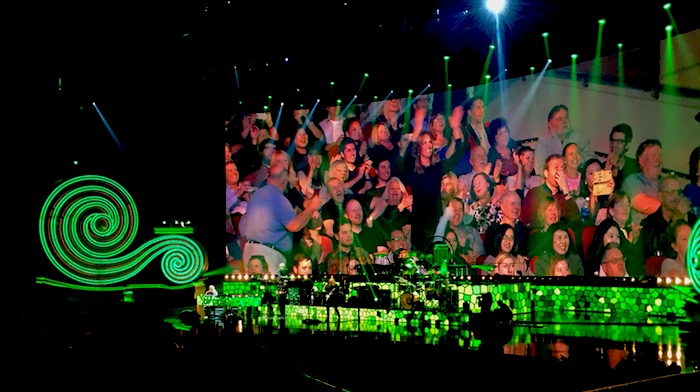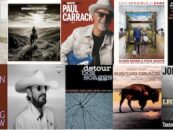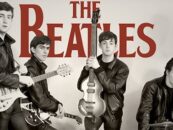
Elton John (backdrop) invites audience members to surround him onstage at Caesars Palace, Las Vegas, Dec. 28, 2016 (Photo by Jeff Tamarkin)
Elton John didn’t sing “I’m Still Standing” until nearly the conclusion of his 18-song, two-hour opening show Dec. 28, 2016, at the Colosseum at Caesars Palace in Las Vegas. By the time he did, he’d already proven the point several times over. To be a world-renowned, 69-year-old rocker and still standing at the tail end of this brutal year of 2016 is something of an accomplishment in itself. To still be at the top of one’s game, skills as a performer undiminished, is remarkable. [Sir Elton turned 70 on March 25, 2017.]
John is fortunate, and he knows it: When he got to the lines, “Don’t you know I’m still standing better than I ever did/Looking like a true survivor, feeling like a little kid/I’m still standing after all this time,” he sang those exultant, defiant words, originally written 33 years ago, with palpable gusto. Many of Elton John’s peers have fallen, and he made reference several times to friends he’s lost—most recently George Michael—and to time-marking events in his own life. This concert was an occasion to reflect and revel in resilience and history: The “Million Dollar Piano” tour—as his latest, three-show mini-run at the famed casino is called (he’ll be back; scroll to bottom for dates)is designed to be a career-surveying retrospective: John released a new album, Wonderful Crazy Night (his 32nd), earlier in 2016, but he did not play a single song from it.
Elton John has aged admirably and with grace. Unlike some of his peers, he doesn’t attempt to be who he was at 25. He still loves a touch of the flash—he emerged to the familiar fanfare of “Also Sprach Zarathustra,” wearing a white cape Liberace would’ve envied, then shed it to reveal his usual natty, sparkly, dark suit (and glittery orange shoes to match)—but he channels most of his exuberance into the playing and singing. John always has been a virtuosic rock pianist and, if anything, he’s gotten even better at it—more nuanced and imaginative on the fly, fearless in his willingness to go deeper and to take great leaps, but smart enough to know when to reel it in. His voice, like that of any older singer, has lost a little range, but none of its distinctiveness. He sounded exactly how you’d want Elton John delivering a greatest-hits show to sound, and those songs, so timeless, all hold up well.
From “The Bitch is Back,” the opening number, John and his band—including four-decade, on-and-off regulars Nigel Olsson (drums), Davey Johnstone (guitar) and Ray Cooper (percussion), joined by bassist Matt Bissonette, keyboardist Kim Bullard and second percussionist John Mahon—were all about precision and expectation. The arrangements were, if not exact duplications of those on the recordings, close enough to render each tune instantly recognizable. When a musician soloed, or when the band as a unit set off on fanciful mini-improvisational excursions, they didn’t veer far. It wasn’t an Elton John jukebox, but it triggered memories without any effort.
Related: Elton first played America 46 years ago!
As early as the second number, “Bennie and the Jets,” John made a point of reminding us that he’s still a musician to be reckoned with. He found holes within the minimalist, crawling, rather repetitive melody lines to toss around a volley of economical blues- and jazz-informed solo licks—not a wasted note in sight—while the band remained largely in lockstep formation save for the occasional hint of an ad-lib.
Watch Elton perform “Bennie and the Jets” at an earlier Caesars concert
John first spoke to the audience following “Bennie,” name-checking other artists who regularly play the Colosseum, including Mariah Carey, whose “tits have left the building,” he quipped, apropos of nothing in particular. He escaped that little contractually obligated sales pitch as quickly as he could, launching into “Rocket Man” solo.
Watch that song performed a few nights’ later
The band members joined him seamlessly, maintaining a light, dreamy touch—acoustic guitar, cymbals, etc.—and, after acknowledging briefly and without elaboration that this has indeed been a sad year, John offered, in reverse order, the two opening songs from his 1971 Madman Across the Water album, “Levon” and “Tiny Dancer.” John’s articulation on the keys, both while soloing and in an ensemble setting, is as impressive as ever: he learned his rock ’n’ roll piano lessons from Jerry Lee Lewis, Little Richard and the other pioneers and then took it all someplace new. When he does lay back to offer a brief spotlight moment to Bissonette or Johnstone, John slips happily and easily into accompanist mode. He’s the undisputed leader, but he’s a team player too.
With 2017 just days away, John spoke at length about his songwriting partnership with lyricist Bernie Taupin, which itself turns 50 in the new year. Astoundingly, John said, he and Taupin have never been in the same room together while writing a song (“That’s why it’s still working,” he surmised): The lyrics are handed to John, who has always composed the music around them. As an example, John cited a certain set of words he was given in 1970. This was the one, he told us, that convinced him that this team had something special. He performed that tune, the still-exquisite and moving “Your Song,” next, entirely solo, on the grand piano, then segued into another tribute, this time to the first responders who helped New York City cope with the 9/11 disaster. Deciding what to perform at the subsequent Concert for New York, a somber occasion meant to show strength and resolve—“I couldn’t very well play ‘Crocodile Rock,’” he said—John chose “Mona Lisas and Mad Hatters,” a song he and Taupin penned for the 1972 Honky Chateau album. As he performed it in Vegas, with Johnstone on mandolin and Bissonette playing standup bass, a video slideshow displayed starkly shot still photos of the diverse faces of New Yorkers, a city that has obviously meant a great deal to John since the beginning of his career when he played halls like the Fillmore East.
“Better Off Dead,” from 1975’s Captain Fantastic and the Brown Dirt Cowboy, and Madman’s “Indian Sunset,” the latter featuring only John and percussion master Cooper, were followed by a lengthy reminiscence of John’s introduction to rock ’n’ roll via Elvis Presley’s “Heartbreak Hotel” and, in the years since, Elton’s appreciation of all of the musical heroes he’s had the fortune of meeting, from Presley himself to Aretha Franklin. The most treasured of those, he said, was his relationship with John Lennon, which ultimately resulted in the first onstage appearance in New York by Lennon since the Beatles, when he joined Elton John at Madison Square Garden in 1974 to a rapturous ovation. “Empty Sky,” the lead track on John’s 1969 debut album of the same name, was performed as a tribute to Lennon, followed by ace renditions of “Goodbye Yellow Brick Road” and “I Guess That’s Why They Call It the Blues.”
If anyone was wondering why John hadn’t mentioned the Christmas Day death of his friend George Michael, he now put that to rest, choking up as he called the singer “one of the most generous people” he’s ever known. Michael, said John, never thought twice about stepping up to help others, but in the end—and John didn’t elaborate on the comment—he was “unable to help himself.” There was no doubt what song would follow: “Don’t Let the Sun Go Down on Me,” originally written by John and Taupin for the 1974 Caribou album, and a #2 Billboard hit at the time, was performed by John and Michael at the 1985 Live Aid concert and reprised by them in 1991, leading to a massive international hit (#1 in the U.S.). With a photo of George Michael projected onto the screen behind the stage, it became one of the most poignant segments of the evening. “I only wish George was here to sing it with me,” John said, visibly shaken.

Elton John and his band at Caesars Palace, Las Vegas, Dec. 28, 2016. Ecstatic audience members are shown on backdrop. (Photo by Jeff Tamarkin)
From there, the only place John could go was to spill out a handful of his other hits, building audience excitement as he and the band spun through “Philadelphia Freedom,” “I’m Still Standing,” “Crocodile Rock” and, finally, “Saturday Night’s Alright for Fighting,” for which he invited several dozen audience members to surround him on the stage. Celebratory rather than chaotic, it was the perfect way to leave things, the artist enveloped by dancing, clapping, adoring fans.
Related: Elton John is one of many classic rock artists who released new albums in 2016
Watch “Saturday Night’s Alright For Fighting” from that same stage a few months later
The fact that John encored with “Circle of Life,” a song he wrote (with Tim Rice, not Taupin) for The Lion King in 1993, forced a listener to consider all of the hit songs Elton John did not sing this night: “Daniel,” “Sorry Seems to Be the Hardest Word,” “Honky Cat,” “Sad Songs (Say So Much),” even “Candle in the Wind.” There were enough of them left out of the set that he could have come back the next night and satisfied the new crowd without repeating himself. There really aren’t many who can say that.
John returns to The Colosseum at Caesars Palace in 2018, with dates from Feb. 9 through May 19. Tickets are available here and here.








1 Comment so far
Jump into a conversationThrough everything, those magical albums of the 70s, loss of friends like Lennon, Princess Diana, Versace, Michael and others, his battle with addiction, Broadway, Academy Awards, and finally his being a father, EJ has always shown pure class. His charity work for AIDS is legendary to say the least. Even though he no longer rules the top of the charts, his concerts, both in the past and the more recent are nothing short of phenomenal. The man is like fine wine, he just keeps getting better.